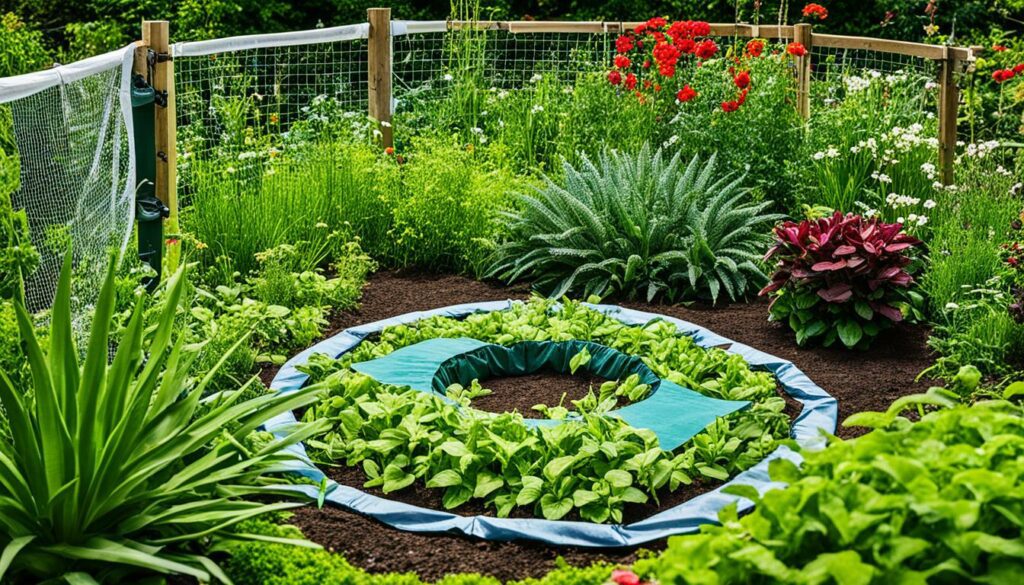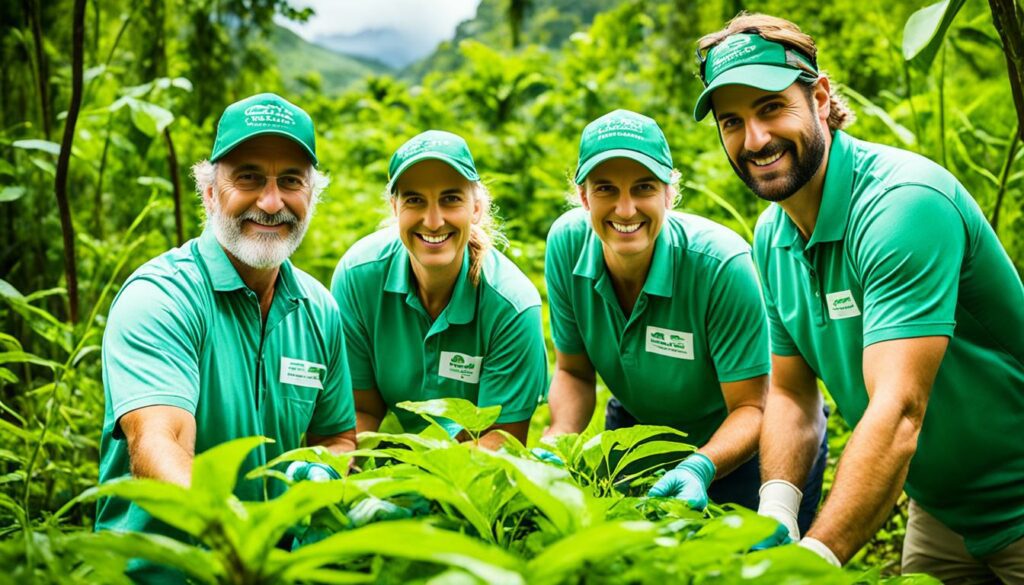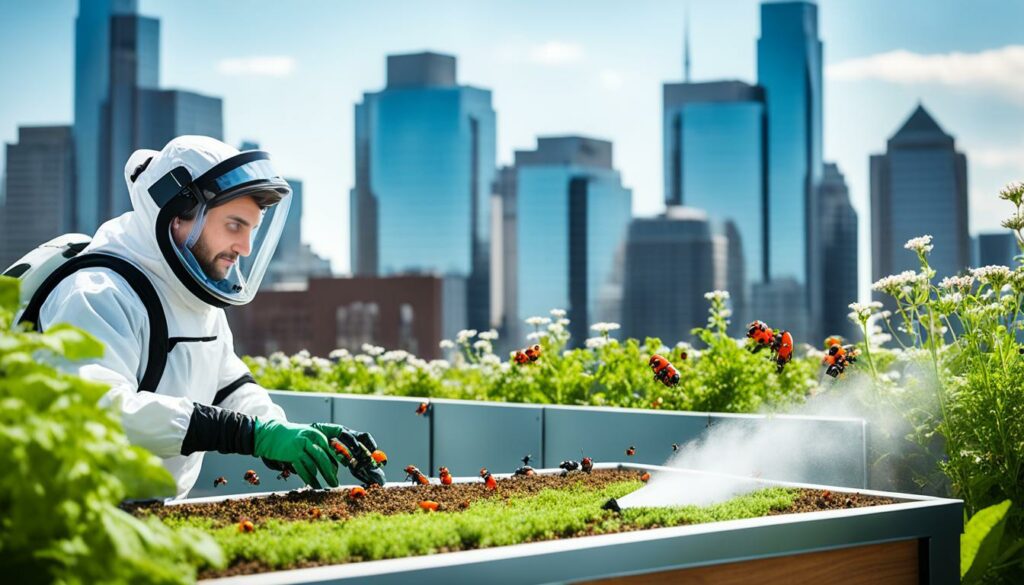Menu

Every summer, I used to worry about chemicals in our garden. With two kids and a sweet smell in the air, using these was troubling. The idea of making our yard pretty at a health cost was hard to accept.
In Texas, many share these worries and are going green in pest control. They want to avoid the health dangers of traditional methods, like breathing problems and cancer. They’re especially worried about their kids’ health.
Traditional pesticides can harm helpful insects and upset nature’s balance. This can cause many environmental problems. But, by using methods that help nature, we can control pests and protect our environment. The focus is on being proactive and gentle with the earth.
It’s vital to see the importance of biodiversity in pest management. This is key for the survival of many invertebrate species. They are critical in balancing ecosystems. Using pesticides harms not just pests but also helpful creatures. This damages the natural order by removing vital creatures.
Integrated pest management (IPM) is a smart way to handle pests. It includes checking, watching, and treating pests carefully. IPM has worked well in places like Texas, Oklahoma, and Louisiana. These areas are important for leading the way in friendly pest control.
Natural pest control services are better for the environment. They bring back more plant types, which means we don’t need as many chemicals. A mix of plants reduces plant-eating bugs by 44%. It also helps insect eaters work 162% harder. This means they eat more pests.
Children can suffer a lot from chemical pesticides. These toxins can cause skin, eye, and breathing problems. They may even link to cancer. So, we’re aiming for natural pest control services. They use good bugs and bacteria to fight pests. They also use traps and make small changes to stop pests.
| Eco-Friendly Practice | Benefits |
|---|---|
| Higher Plant Diversity | Reduces herbivore feeding rates by 44% |
| Integrated Pest Management (IPM) | Long-term effectiveness in managing pest issues; reduces reliance on chemicals |
| Organic Pesticides | Safer for humans, pets, and environment due to biodegradability |
| Physical Control Methods | Prevents pest incursion through traps, barriers, and environmental modifications |
| Bio-Control Methods | Uses natural enemies for targeted pest population control |
I strongly believe in the importance of biodiversity. It builds the core of integrated pest management and natural pest control. Diverse farming and less chemicals protect our future. Monoculture farming can lead to pest problems. So, using a variety of plants is vital for our planet and people.
Pesticides are used to control pests but often do more harm than good. They don’t just target harmful bugs. They kill the helpful ones too. This harms the variety of life and all the creatures in that area. It’s crucial to use safer methods to keep our environment healthy.
The use of chemical pesticides has led to a big drop in flying insects over the past 27 years. This was noted in a study in 2017 by Hallmann CA et al. These pesticides kill both the bad bugs and the good ones. But, we need the good ones for pollinating plants and keeping the pests in check. For example, bees are being highly affected by these pesticides, which hurts their role in pollinating plants.
Pesticides are not just affecting flying insects. They’re also harming life in streams and ponds. Studies show that pesticides in Japan are hurting fish and other water animals. In these areas, the number of different water insects has gone down by 77% because of these chemicals. Furthermore, the effect is even worse in places with concrete, where insect numbers drop even more.
Even though these waters make up just a tiny part of the Earth, they house a lot of different species. These chemicals are putting many of these species at risk. This is because water environments support a great deal of life. Tainting them with these pesticides damages entire ecosystems.

But, not all hope is lost. Some places like Japan’s irrigation ponds are showing they can withstand the impact of pesticides. They keep a lot of different insects and plants alive, some of which are in danger. It shows we can preserve these important areas against pesticide harm. We need to focus on protecting them through using safer pest control methods.
Ecological pest control means using methods to keep pests away, such as creating homes for animals that eat pests. This approach falls into two main types: preventing pests from coming and making places for their natural enemies to live. Both methods are key to a complete and long-term way to deal with pests.
Preventing pests is a big part of eco-friendly pest control. By planting many different crops, like the 90 kinds at EarthDance, crops are less likely to get pests and diseases. Having lots of different plants around can make it harder for pests to find a good place to live. Also, farmer Edmund Frost made squash plants that pests don’t like, reducing the need for chemicals.
Another good way to stop pests is by changing the crops in a field each year. This method, as shown in UC Davis’s work, can help stop pests from growing in numbers and keep the soil healthy. It’s important not to grow the same crop all the time, as pests can get too comfortable and cause big problems.
Giving animals that eat pests a place to live is very important in eco-pest control. Research from UC Davis shows that barn owls, for example, can help a lot by eating rodents. By putting up homes like nest boxes and keeping some plants low to the ground, farmers can welcome these helpful creatures.
These special spots for animals help create a balanced ecosystem that naturally controls pests. The SARE-funded study in Washington even proves that this approach can greatly lower the need to use harmful chemicals. These methods work together to keep nature in balance and promote farming that lasts a long time.
| Farm/Study | Practice | Benefit |
|---|---|---|
| EarthDance Farm | Organic farming on 2.3 acres | Grows almost 90 varieties of crops, enhancing plant resilience |
| UC Davis Study | Cover crops for weed suppression | Breaks pest cycles and improves soil health |
| Twin Oaks Seed Farm | Disease-resistant squash varieties | Decreases reliance on chemical inputs |
| UC Davis Research | Role of barn owls in rodent control | Significant reduction in rodent population |
| Washington Winegrape Growers | Ecological farm practices | Substantial reduction in pesticide use |
Focusing on natural pest control boosts ecological pest management. It’s all about enhancing natural methods. By introducing various plants and animals, we guard against pests without using many chemicals.

Working with nature is effective. For example, we can use ladybugs to eat aphids. Nematodes are great for controlling pests in the soil. Also, Bacillus thuringiensis (Bt) is a safe and targeted way to fight insect larvae on crops.
| Organic Method | Target Pest | Benefits |
|---|---|---|
| Ladybugs | Aphids | Non-toxic, boosts biodiversity |
| Nematodes | Grubs and Termites | Soil health improvement |
| Bacillus thuringiensis (Bt) | Insect Larvae | Targeted pest control |
Using physical barriers and traps is smart and green. Sticky traps catch bugs without poison. Items like citrus peels and coffee grounds keep bugs away. Using food scraps for pest control is good for the environment too.
Adding different plants and animals helps control pests naturally. Birds, wasps, spiders, and even neem oil play key roles. They keep pest numbers down and help crops stay healthy.
Opting for these methods improves our planet. They manage pest issues at the root and are better for the Earth. Let’s look to these solutions for a sustainable future.
In conservation biological control (CBC), the aim is to bring back or boost helpful insects in farmlands. This boosts the natural control of pests. It’s key in making pest control friendly to nature and keeping our varied plant and animal life. Many groups and schools are at the forefront of this effort. They show and use CBC ways.
The Xerces Society teamed up with the USDA NRCS and the Uni of Cali–Berkeley. They did field work to prove that CBC works. They also made a handy guide to planning habitats for useful bugs. It explains about different native bugs and how to use CBC well. Michigan State Uni, the Uni of Cali, and Oregon State Uni also help with gathering information on attracting useful bugs. They give advice on making homes for these bugs to naturally control pests.
Many techniques can bring friendly bugs into farms to control pests. Oregon State Uni’s IPM Center, for example, worked on a guide called “Farming For Pest Management”. It helps farmers see how CBC can fit their needs. The USDA-NRCS in Colorado and schools like Uni of Minnesota and Cornell offer tips too. They show how making the right habitats is vital for useful bugs. Also, Sustainable Agriculture Research & Education (SARE) and ATTRA help with ideas. They suggest cover crops and landscaping that supports good bugs. Using these methods helps bring back natural enemies. It also makes our farms more diverse and eco-friendly.
Cultural pest management is key in keeping agriculture sustainable. It’s all about stopping pests before they become a problem. This means using things like crop rotation and growing different crops together.

Farmers use crop rotation to mess up pest life cycles. This stops pests from getting too comfy in one place. The organic farming rules even say that farmers must change the crops they grow. This helps keep soil and crops healthy and reduces pest problems.
Growing lots of different crops also helps fight pests naturally. It makes the farmer’s land less attractive to harmful bugs. This way, farmers can protect their crops without using harmful chemicals.
Stress management tactics make it hard for pests to grow out of control. Farmers might take away what pests like to eat or use things to confuse them. These include floating covers and keeping pests out.
Integrated pest management (IPM) uses these tactics and more. It’s a smart mix of using natural approaches and keeping an eye on things. This way, farmers can keep their fields healthy and their crops safe without causing harm to the environment.
Farmers follow an Organic System Plan to use these methods. This plan is set by the National Organic Program. It helps farmers work in a way that’s good for the planet and its creatures.
In biological pest control, we use nature’s friends to fight harmful pests. This keeps pest numbers low without lots of chemicals. By adding helpful creatures like predators and parasites, we find a natural balance in managing pests.
Adding beneficial insects to our environment is key in battling pests. These insects, such as lady beetles and parasitic wasps, help keep pests at bay. Organizations like Xerces offer tips for including these helpful bugs in our spaces via farming with native beneficial insects. This shows us how to encourage these good insects to help out.
Keeping our ecosystems diverse is crucial for handling pests in a natural way. One method, known as conservation biological control, adds beneficial bugs back to farming areas. Experts from groups like the Xerces Society show this method works well. They prove that natural habitats for helpful bugs boost pest control without chemicals.
Encouraging a wider variety of species makes farms stronger against pests. This cuts down on the need for harmful chemicals. Choosing conservation biological control promotes a healthier ecosystem. It stands for looking after nature to help our farms thrive.
Organic and green pest control methods are an excellent choice over common chemicals. They protect the environment and our health by using natural and organic materials. This approach also helps reduce the use of harmful chemicals, promoting sustainability.

Eco-friendly pest control is as effective as traditional methods. It uses natural and organic materials to reduce harm to other species. Studies confirm these methods are safe for the environment and people, making them ideal for homes and farms. Using natural predators, organic repellents, and biological controls helps manage pests without chemicals.
Reducing pesticide use is key in green pest control. Keeping gardens clean, using natural items, and home hygiene cuts the need for chemicals. For tough bugs, green pest control professionals have eco-friendly options. This protects helpful bugs and stops soil and water pollution.
Traditional methods need lots of applications which damage plants and ecosystems. On the other hand, organic ways prevent pest problems and support long-term ecological health. People now see the dangers of pesticides on health, pushing for more organic and green pest control solutions.
To control pests well, it’s key to have lots of different plants in and near farms. Using many plant types helps keep farms healthy, especially when growing crops without using much chemical help. This way of farming has success in many places.
Mix up the land with different plants, especially trees and bushes, and bugs won’t bother the crops as much. At a farm called EarthDance, planting over 25 kinds of native flowers drew in useful pollinators. Also, Steven Haring found that planting certain crops in California made weeds less of a problem.
Some strawberry farms have shown that having a big variety of plants can cut down on using chemicals. This method matches well with sustainable pest management. EarthDance farm is a good example, growing nearly 90 crop types on a small area with eco-friendly methods to beat pests.
It’s not just about plants. Getting birds like barn owls and hawks to eat farm pests is also smart. In California, these birds help keep pests under control by eating lots of mice and voles. This shows how having many types of life around farms can naturally fight pests.
To make biodiversity-friendly pest control work well, community support for biodiversity, and biodiversity-friendly policies play a key role. The UN emphasises the need to weave biodiversity into sustainable development efforts, offering more than 50 ways to support biodiversity. These cover areas such as respecting human rights, fostering peace, and ensuring our planet stays stable.
For instance, efforts include enhancing rights protection at the local level and making sure people can access clean water and enough food. The UN names key agencies like UNEP, UNDP, OHCHR, FAO, and IFAD to help turn these ideas into reality. These efforts link to Sustainable Development Goals, which help measure the progress.

Strategies focus on using nature-based solutions for managing water and increasing its farm use efficiency, and fairness in water access. This approach meets both environmental and human needs. It also highlights the vital role that indigenous groups and locals play. It recognises their wisdom and the value of their traditions.
Fighting the ill effects of conflicts on biodiversity is crucial. It’s also important to connect efforts to save nature with reducing poverty and meeting environmental rights. The UN works very hard to include biodiversity in its plans and actions. This means that community and policy support is ready to help with biodiversity-friendly pest control.
Using eco-friendly ways to tackle pests is hard. This is because of the costs and the ways we’re used to. Integrated Pest Management (IPM) is a great choice over old methods. Yet, it can cost more at the start, which puts some off. People also find IPM complex and are long used to doing things a certain way.
IPM works well in the long run but needs money upfront. For example, training in new methods and using natural controls may not make cash straight away. But, in time, these methods can save money. The cost from the start is a big issue for many.
Another challenge is the love for chemical pesticides. People are often used to them and so fear new methods. This is why more education is vital. Farmers need to know the benefits of using eco-friendly ways, like less pest resistance and helping the planet. This might help them choose these better methods.
To solve these hurdles, everyone must work together. This means farmers, companies that make pest chemicals, and experts in crops need to talk. They can share information about the good points of eco-friendly methods. This will help everyone see why they should change.
| Challenges | Impact | Solutions |
|---|---|---|
| High Initial Costs | Financial deterrent for farmers | Highlight long-term savings; provide subsidies |
| Perceived Complexity | Reluctance to adopt new methods | Increased educational awareness |
| Entrenched Practices | Resistance to change from traditional pesticides | Promote success stories; policy support |
The way we handle pests is changing, moving towards methods that protect biodiversity. New science and working together are making these changes happen. They’re the key to a future where we can manage pests without harming the planet.
Integrated Pest Management (IPM) is becoming more popular. People want pest control that’s thorough and uses natural methods. This demand is helping the industry grow, with over 34,000 companies in the US expected to make more money.

Now, pest controllers are using drones to apply chemicals. This high-tech approach is precise and uses fewer chemicals. At the same time, more people prefer less harmful pest control methods. Increased awareness about the dangers of common insecticides is pushing this change.
Legal steps like the California Ecosystems Protection Act are also important. These laws are needed to protect the environment and keep it healthy. With a shortage of workers, new tech is crucial to staying effective.
With diseases like malaria spreading again in certain states, natural pest control is urgent. About 30% of people who fight mosquitoes are already looking for eco-friendly options. This demand is growing yearly.
“Professionals predict continued market growth and technological advancements will be crucial to overcoming both current and future challenges in pest management.” – Industry Expert
The future of pest control depends on getting better at working with nature. By working together, farmers, scientists, and policymakers can improve how we protect our environment and farm sustainably.
| Key Influencers | Impact |
|---|---|
| Integrated Pest Management (IPM) | Widely adopted; reduces reliance on chemicals |
| Technological Innovations (e.g., Drones) | Improves precision and reduces chemical use |
| Environmental Policies | Shapes sustainable practices and promotes ecosystem health |
| Consumer Demand for Natural Solutions | Increases market for eco-friendly pest control |
Studying biodiversity and pest control in organic farms has shown great results. Farmers using these methods see more crops growing and healthier ecosystems. This approach benefits everyone.
Organic farms flourish by introducing more species. In the Brazilian Cerrado, researchers highlighted the benefits of varied farming. Their work showed a mix of plants led to more helpful bugs, controlling pests better.
In India, too, organic methods are successful. By encouraging the growth of natural predators, like in the case of the papaya mealy bug, farmers can control pests effectively.
Various biological methods have shown to work well worldwide. For instance, using ladybugs to control pests on plants has been a big success. This proves that nature can help control pests in a way that’s safe and long-lasting.
Adding biodiversity to farms has big benefits. In Brazil, using natural controls saved money and lowered pesticide use. This research underlines how important it is to use eco-friendly pest control.
These eco-friendly methods also have broad positive effects. A study in Guatemala and a global shift away from harmful farming methods both confirm this. They show that moving towards green pest control is a great step forward.
| Region | Study/Impact |
|---|---|
| Northwestern Petén, Guatemala | 395–407 cases regularised (Gould KA, 2006) |
| Global Tropics | Reduction in swidden cultivation (van Vliet N et al., 2012) |
| Brazil | Subsidized settlements reducing deforestation (Peres CA and Schneider M, 2012) |
Moving towards eco-friendly ways to manage pests is crucial. It is essential for our farms to stay productive and for the environment to stay healthy. Using synthetic pesticides harms our health and nature. We need to switch to Integrated Pest Management (IPM). IPM methods focus on preventing pests before they become a problem. This reduces the need for harmful chemicals.
Choosing natural options is a big part of managing pests safely. Essential oils, like peppermint, lavender, and tea tree, keep insects away. They are safe for us and the environment. Adding helpful bugs, such as ladybirds, can also keep pest numbers down. This helps increase the variety of life around us. Setting up barriers, like fixing cracks in walls and using screens, stops pests from entering our spaces.
An eco-friendly approach involves more than just not using chemicals. It’s about making our living spaces healthier and supporting sustainable ways. Using organic pest control products lowers the dangers that come with synthetic chemicals. Brands like BRD Pest Solutions use methods that harm fewer other animals. This helps keep the balance in nature. Moving to these green pest management ways is a big step for a brighter, eco-friendlier future.
Biodiversity-friendly pest control helps keep the ecosystem balanced. It protects and enriches biodiversity. For this, natural predators, homes for good insects, and preventive steps are used.
Ecological pest control goes for prevention and uses natural ways to handle pests. It might increase the variety of plants and change planting areas. On the flip side, traditional approaches depend a lot on harmful chemical sprays.
Injecting biodiversity into pest control builds a strong ecosystem. It lets pest enemies flourish, cutting down chemical use. This helps make an environment that lasts longer and grows better crops.
There are many bad sides to chemical drugs. They can hurt good bugs and poison the earth and water. They don’t just target harmful pests but also kill off useful creatures, which drops our green variety.
To prevent pests, ecological methods use varied crops, rotation, and resistant plants. These steps deter pests from settling in and thriving. This cuts down on the need for urgent actions later.
Designing homes for pest-eaters like birds and tiny wasps lets them do their job better. This approach boosts the fight against pests naturally. The result is a more balanced and lastingly pest-free area.
Crop rotation is vital in cultural pest control. It interrupts pest life cycles and lessens infestation chances. By changing crops’ places, farmers make it hard for pests to find a permanent home.
Using nature’s own killers, like ladybirds for aphids, is what biological control does. It helps keep nature’s checks in place, files down chemical use, and makes the environment flourish.
Options to toxic sprays include plant-based, bacterial, and pheromone solutions. They pinpoint only the pests that need to go, leaving friends and surroundings safe.
Saying no to too many chemicals boosts crops by making the ecosystem stronger and more varied. It brings better pest fighting power and fewer needs for harmful substances. The farm thrives better and longer.
To cheer on wildlife-respecting pest control, we need rules for saving, green farming perks, and safe bug-killing studies. Good policies cue us to care for the earth in this smart way.
Going green in farming fights costs and the big change to new methods. Plus, sticking to old chemical habits can make it tough. Smart support and learning are key to jump these hurdles.
Tomorrow’s way to guard our crops will mix science, farmer tips, and good laws. We’ll push for smarter ways to live and let live with bugs, aimed at lasting and effective pest control.
There are many organic success tales, showing how good pest plans can improve crops and nature. They point the way to how farming should be: healthy, rich, and full of life.